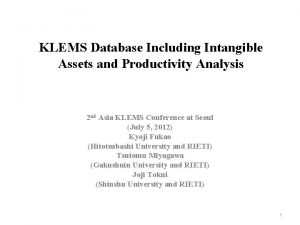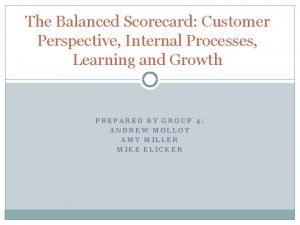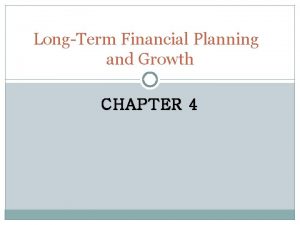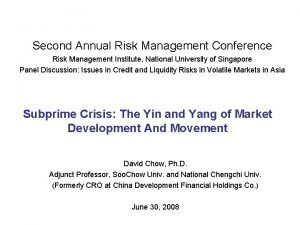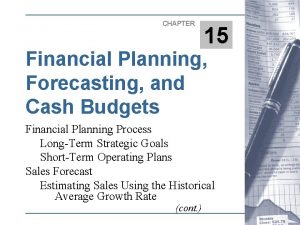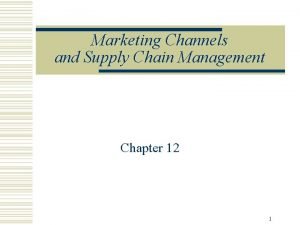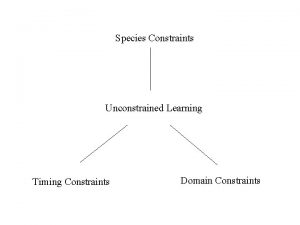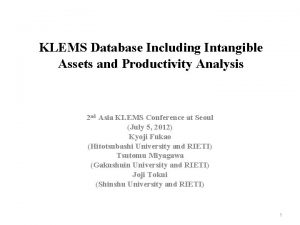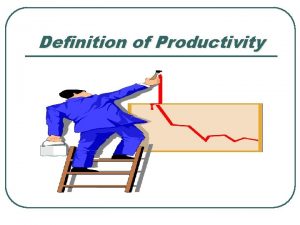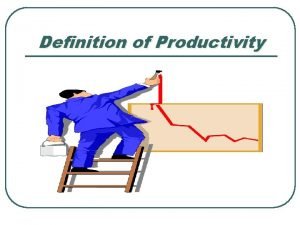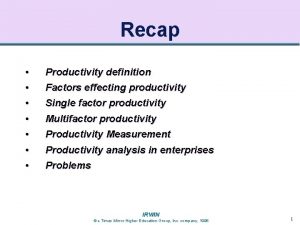Productivity Growth and Financial Constraints World Klems Conference































- Slides: 31

Productivity Growth and Financial Constraints World Klems Conference - Harvard – 4 th June 2018 Philippe Aghion Antonin Bergeaud Gilbert Cette Rémy Lecat Hélène Maghin

Based on: - Antonin Bergeaud, Gilbert Cette and Remy Lecat « Productivity Trends in Advanced Countries Between 1980 and 2012 » The Review of Income and Wealth, vol. 62(3), September 2016, pp. 420 -444 - Antonin Bergeaud, Gilbert Cette and Remy Lecat « Total Factor Productivity in Advanced Countries: A Long Term Perspective » International Productivity Monitor, Number 32, Spring 2017, pp. 6 -24. - Gilbert Cette, Simon Corde and Rémy Lecat « Stagnation of productivity in France: A legacy of the crisis or a structural slowdown? » Economics and Statistics, n° 494 -496, 2017, pp. 11 -36 - Gilbert Cette, Simon Corde and Rémy Lecat « Firm level Productivity dispersion and Convergence » Banque de France, Working Paper n° 662, 2018, February Economics Letters, Vol. 166, May, pp. 76 -78 - Philippe Aghion, Antonin Bergeaud, Gilbert Cette, Remy Lecat and Helene Maghin « The Conteracting Effects of Credit Constraints on Productivity: Theory and Evidence » Mimeo, 9 th May 2018 - Antonin Bergeaud, Gilbert Cette and Remy Lecat « Interest rates and productivity: an empirical analysis on macro level data » Ongoing research 2

Content Main messages 1. Introduction: A general productivity slowdown 2. The story tested 3. Data 4. Financial constraints and productivity 5. Conclusion 3

Main messages Ø General productivity slowdown in OECD countries and real long-term interest rates decrease since the 1980 s Ø At the firm level, lower financial constraints o Easier for innovators to finance innovation positive impact on productivity o Less cleansing, less entry, damage ressource allocation negative impact on productivity Ø At the aggregate level, concave relationship between financial constraints and productivity o Low FC Impact of lower cleansing dominates o High FC Impact of lower innovation financing dominates Ø At the country level, productivity and interest rates: a circular relationship o Slowdown in productivity lower interest rates as long-term capital return decreases o Lower interest rates slowdown in productivity as survival of less productive firms (lower cleansing) and investment in less profitable project 4

Main messages Ø Since the 1990 s, increase in the dispersion of productivity between firms as a consequence of the lower cleansing mechanisms Ø During the financial crisis, lower interest rates weighed on productivity growth but supported activity and employment by keeping alive less productive firms Ø In the upturn, increasing interest rates will support productivity growth 5

1. Introduction: a general productivity slowdown GDP annual growth (in %) and contributions (in pp) 1890 – 2016 - Whole economy Source: Bergeaud, Cette and Lecat (2016) - See: www. longtermproductivity. com 4 4 3 3 2 2 1 1 0 0 -1 -1 United Euro Area United States Kingdom Japan Germany France Italy TFP Capital deepening Population Employment rate Hours worked per worker GDP Spain o Main GDP growth driver: Productivity growth. And within productivity: TFP growth 6

1. Introduction: a general productivity slowdown GDP annual growth (in %) and contributions (in pp) – Whole economy Source: Bergeaud, Cette and Lecat (2016) - See: www. longtermproductivity. com USA TFP Employment rate Euro Area United Kingdom Capital deepening Hours worked 2005 -2016 1995 -2005 1975 -1995 1950 -1975 1913 -1950 -1 1890 -1913 -1 2005 -2016 0 1995 -2005 0 1975 -1995 1 1950 -1975 1 1913 -1950 2 1890 -1913 2 2005 -2016 3 1995 -2005 3 1975 -1995 4 1950 -1975 4 1913 -1950 5 1890 -1913 5 2005 -2016 6 1995 -2005 6 1975 -1995 7 1950 -1975 7 1913 -1950 8 1890 -1913 8 Japan Population GDP o Since WW 2, growth decrease in the main developed areas except for 1995 -2005 in US and UK thanks to ICT o Main factor of this growth decrease: TFP slowdown. Risk of Secular Stagnation? 7

1. Introduction: a general productivity slowdown GDP annual growth (in %) and contributions (in pp) – Whole economy Source: Bergeaud, Cette and Lecat (2016) - See: www. longtermproductivity. com 7 6 6 5 5 4 4 3 3 2 2 1 1 0 0 -1 -1 -2 -2 1890 -1913 1913 -1950 1950 -1975 1975 -1995 1995 -2005 2005 -2016 1890 -1913 -1950 -1975 -1995 -2005 -2016 7 Euro Area Germany France Italy Spain TFP Capital deepening Population Employment rate Hours worked GDP o Same slowdown in the main EA countries Except in Spain, over 1995 -2004, but unsustainable growth o Main factor of this growth decrease: TFP slowdown. Risk of Secular Stagnation? 8

1. Introduction: a general productivity slowdown Average annual growth rate of labor productivity per hour Smoothed indicator (HP filter, λ = 500) - Whole economy – 1891 -2016 – In % Source: Bergeaud, Cette and Lecat (2016) - See: www. longtermproductivity. com 9% 7% 5% 3% 1% 18 9 18 0 9 19 5 0 19 0 0 19 5 1 19 0 1 19 5 2 19 0 2 19 5 3 19 0 3 19 5 4 19 0 4 19 5 5 19 0 5 19 5 6 19 0 6 19 5 7 19 0 7 19 5 8 19 0 8 19 5 9 19 0 9 20 5 0 20 0 0 20 5 1 20 0 15 -1% United States o US: one big wave over the 20 th Century, pause during Great Depression, small wave between 1995 -2005 9

1. Introduction: a general productivity slowdown Average annual growth rate of labor productivity per hour Smoothed indicator (HP filter, λ = 500) - Whole economy – 1891 -2016 – In % Source: Bergeaud, Cette and Lecat (2016) - See: www. longtermproductivity. com 9% 7% 5% 3% 1% 18 9 18 0 9 19 5 0 19 0 0 19 5 1 19 0 1 19 5 2 19 0 2 19 5 3 19 0 3 19 5 4 19 0 4 19 5 5 19 0 5 19 5 6 19 0 6 19 5 7 19 0 7 19 5 8 19 0 8 19 5 9 19 0 9 20 5 0 20 0 0 20 5 1 20 0 15 -1% United States Euro Area o US: one big wave over the 20 th Century, pause during Great Depression, small wave between 1995 -2005 o Slowdown to historical lows from the mid 2000 s in all areas. Already shown in an abundant literature, see Crafts et 10 O’Rourke, 2013…

1. Introduction: a general productivity slowdown Average annual growth rate of labor productivity per hour Smoothed indicator (HP filter, λ = 500) - Whole economy – 1891 -2016 – In % Source: Bergeaud, Cette and Lecat (2016) - See: www. longtermproductivity. com 9% 7% 5% 3% 1% 18 9 18 0 9 19 5 0 19 0 0 19 5 1 19 0 1 19 5 2 19 0 2 19 5 3 19 0 3 19 5 4 19 0 4 19 5 5 19 0 5 19 5 6 19 0 6 19 5 7 19 0 7 19 5 8 19 0 8 19 5 9 19 0 9 20 5 0 20 0 0 20 5 1 20 0 15 -1% United States Euro Area United Kingdom Japan o US: one big wave over the 20 th Century, pause during Great Depression, small wave between 1995 -2005 o Slowdown to historical lows from the mid 2000 s in all areas. Already shown in an abundant literature, see Crafts et 11 O’Rourke, 2013…

1. Introduction: a general productivity slowdown Average annual growth rate of labor productivity per hour Smoothed indicator (HP filter, λ = 500) - Whole economy – 1891 -2016 – In % Source: Bergeaud, Cette and Lecat (2016) - See: www. longtermproductivity. com 18 9 18 0 9 19 5 0 19 0 0 19 5 1 19 0 1 19 5 2 19 0 2 19 5 3 19 0 3 19 5 4 19 0 4 19 5 5 19 0 5 19 5 6 19 0 6 19 5 7 19 0 7 19 5 8 19 0 8 19 5 9 19 0 9 20 5 0 20 0 0 20 5 1 20 0 15 8% 7% 6% 5% 4% 3% 2% 1% 0% -1% -2% Euro Area Germany France Italy Spain Netherlands o Euro area countries: lagged big wave during the Golden age, no small wave except for the UK o Slowdown to historical lows from the mid 2000 s in all areas 12

1. Introduction: a general productivity slowdown … Real long-term interest rate (In %) - 10 -year sovereign bonds Source: OECD o Long term real interest rate decline in all areas since the mid-1980 s o Which relationship with the productivity slowdown? 13

2. The story tested Ø On individual data, results apparently contrasted in the literature regarding the impact of financial constraints/high real interest rates on average productivity growth o Favorable impact Through cleansing mecanisms (closing of low-productivity firms and reallocation of their labour and capital to more productive firms) Gropp, Rocholl and Saadi (2017); … o Detrimental impact Through IT investment, R&D, innovation, management quality… Aghion et al. (2012); Duval, Hong and Timmer (2017); Manarasi and Pierri (2018); … 14

2. The story tested Ø If the two mecanisms coexist, which one dominates currently at the macro level? Ø Seems to be the first one (favourable impact) See Reis (2013) ; Gopinath et al. (2015), Gorton-Ordonez (2015) ; G. Cette, J. Fernald and B. Mojon (2016), C. Borio, E. Kharroubi, C. Upper and F. Zampolli (2016), … Ø But the two are playing 15

2. The story tested The two opposite impacts of financial constraints at the macro level Ø Productivity impact of financial constraints at the aggregate level: An inverted U curve We would curently be in the left part of the curve 16

2. The story tested At the macro level … Ø … Circular relation between TFP growth and real interest rates o Real interest rates + factor quality + (institutions, technology) TFP growth Consistent with an abundant literature (see above) o TFP growth + other factors (demography …) => GDP growth real interest rates Consistent with an abundant literature, see among numerous papers M. Marx, B. Mojon and F. Velde (2017); … Ø … Without technology shocks and appropriate institutions, risk of Secular Stagnation 17

2. The story tested • 18

2. The story tested Productivity of frontier and laggard firms in France (Cette, Corde and Lecat, 2018) Decreasing cleansing mechanims seems observed (Data from FIBEN) Ø Frontier = most productive firms each year No slowdown at the frontier Declining diffusion from the frontier to laggard firms? Similar results as Andrews et al. (2016) 19

2. The story tested Productivity dispersion in France (Cette, Corde and Lecat, 2018) Decreasing cleansing mechanims seems observed (Data from FIBEN) Ø Apparent σ divergence since the early 2000 s, before the crisis This could explain the average productivity slowdown Slowdown in the destructive creation process? Interdecile productivity dispersion (D 9 -D 1)/(D 1+D 9) 20

3. Data (ABCLM) Ø Cotations aggregated into 3 categories o Category A: 3++, 3 et 4+ o Category B: 4 et 5+ o Category C: less than 5 (including firms that experienced a payment incident) Ø Sources o Fi. BEn 2004 -2014 ~30 k firms per year (private manufacturing sector) o Interest rate comes from Mcontran (new loans with various maturity) o Cotation (rating) comes from Banque de France 21

3. Data (ABCLM) o Good ratings are related : • Negatively with the level of interest rates granted • Positively with the loan amount o Poor ratings are related: • Positively with the level of interest rates granted • But not with the amount granted o => Ratings are related to financial constraints 22

4. Financial constraints and productivity (ABCLM) o Spread is defined as the average interest rate in a given sector at a given year minus the EONIA o Higher spreads increase TFP growth up to a threshold and then decrease TFP growth in sectors that depends the most on external financing 23

4. Financial constraints and productivity (ABCLM) The two opposite impacts of financial constraints Ø Empirical evidence of the productivity impact of financial constraints at the industry level: An inverted U curve o Each dot represents a sector in a specific year from 2004 to 2014 o TFP growth and interest rate spread have been residualized on a sector fixed effect o Manufacturing sector with an index of external financial dependence set to 1 (based on the RZ indicator). 24

4. Financial constraints and productivity (ABCLM) o TFP level and growth in better-rated firms are higher than in other firms o => Financial constraints damage productivity of incumbent firms 25

4. Financial constraints and productivity (ABCLM) o Ratings efficiently capture default risk (col. 1 -2) o Bad ratings, taken as an indicator of financial constraints, tend to increase the risk of default for lowproductivity firms (col. 3 -5) o This illustrates the cleansing mechanism: financial constraints increase the default probability of low-productivity firms 26

4. Financial constraints and productivity (ABCLM) Ø Euro area banks may use corporate loans as collateral in their refinancing operations with the ECB o Before 2012, only credits rated 4+ or higher were eligible o From 2012, extension to credit rating 4 Ø Announcement was made at the end of 2011 and was largely unanticipated by companies. Result: exogenous positive shock of access to credit for companies in rating 4 in 2012 compared to their situation at the end of 2011. Corresponds to a part of our category B Ø This ACC program has already been the subject of two studies at the Bd. F: Cahn et al. (2017) and Mesonnier et al. (2017). The latter finds quantitatively low effect that mostly concern interest rates while the former finds positive effect on the loan supplied to single bank firms Ø We use this schock to avoid endogeneity biaises 27

4. Financial constraints and productivity (ABCLM) o Treatment group: rating = 4 ; control group : rating = 5+ in 2011 o Prior to the ACC, the evolution of the value of new loans were not significantly different for firms rated 4 and 5+ in 2011. o The trends became significantly different from the ACC in 2012: financial constraints became lower for rating = 4 than for rating = 5+ o The ACC has modified the credit supply to firms with rating = 4 28

4. Financial constraints and productivity (ABCLM) o TFP growth increases for firms that benefited from the eligibility shock (col. 1) o It is valid only for firms that are in sectors with strong dependance on external financing (col. 2 -3) o Placebo tests (col. 4 -7) support the fact that no other ratings effect is at play 29

4. Financial constraints and productivity (ABCLM) o Default risk decreased for firms which were hit by the eligibility shock (col. 1 -3) o This effect is stronger for low-productivity firms (col. 4 -5) 30

5. Conclusion Ø Two opposite impacts on productivity growth of financial constraints / real interest rates. Increasing real interest rates / financial constraints … o … pushes up productivity through the cleansing mechanisms o … makes more difficult to finance risky and innovative projects Ø During the crisis, the cleansing mechanism dominated o low interest rates weighed on productivity growth … o … but supported activity and employment, as factor reallocation was slowed. Ø The productivity growth triggered by the digital economy will be boosted by interest rate increase and higher cleansing 31
 Klems database
Klems database Eu klems database
Eu klems database Eu klems
Eu klems Accounting constraint
Accounting constraint Growth analysis
Growth analysis Root hair structure
Root hair structure Primary growth and secondary growth in plants
Primary growth and secondary growth in plants Vascular ray
Vascular ray Internal customer perspective
Internal customer perspective Long term financial planning and growth chapter 4
Long term financial planning and growth chapter 4 Long term financial planning and growth chapter 4
Long term financial planning and growth chapter 4 Long term financial planning and growth
Long term financial planning and growth Step growth polymerization vs chain growth
Step growth polymerization vs chain growth Geometric growth population
Geometric growth population Neoclassical growth theory vs. endogenous growth theory
Neoclassical growth theory vs. endogenous growth theory Organic vs inorganic growth
Organic vs inorganic growth Financial risk management conference 2018
Financial risk management conference 2018 Financial education conference
Financial education conference Financial and non financial motivation
Financial and non financial motivation Marriages and families changes choices and constraints
Marriages and families changes choices and constraints Marriages and families changes choices and constraints
Marriages and families changes choices and constraints Chapter 15 financial forecasting for strategic growth
Chapter 15 financial forecasting for strategic growth World cashew conference
World cashew conference Asq world conference
Asq world conference Iave world volunteer conference
Iave world volunteer conference World maritime technology conference
World maritime technology conference World health organization growth charts
World health organization growth charts Channel design decisions in marketing
Channel design decisions in marketing Example of rheonomic constraints
Example of rheonomic constraints Specifications and constraints
Specifications and constraints Constraints and statical determinacy
Constraints and statical determinacy Difference constraints and shortest paths
Difference constraints and shortest paths
